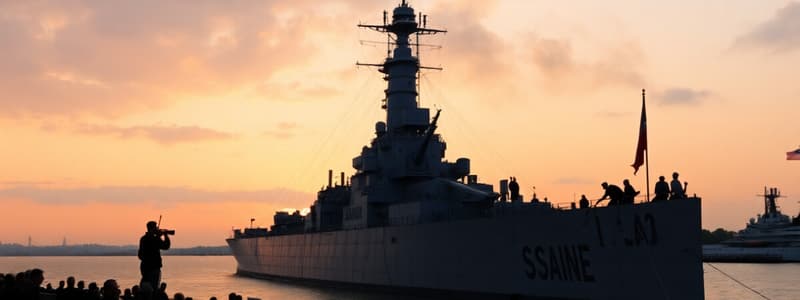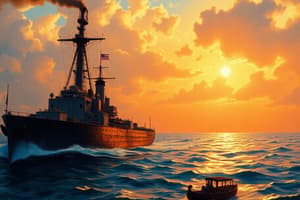Podcast
Questions and Answers
Which event directly preceded the United States declaring war on Spain in 1898?
Which event directly preceded the United States declaring war on Spain in 1898?
- The sinking of the USS Maine in Havana Harbor (correct)
- The completion of the Panama Canal
- The election of William McKinley as president
- The publication of the de Lome Letter
What was the primary goal of the Teller Amendment?
What was the primary goal of the Teller Amendment?
- To annex Cuba as a U.S. territory after the Spanish-American War
- To establish military bases in Cuba indefinitely
- To allow the U.S. to control Cuba's economy
- To guarantee Cuba's independence after the Spanish-American War (correct)
Which territory did the United States NOT acquire as a result of the Spanish-American War?
Which territory did the United States NOT acquire as a result of the Spanish-American War?
- Guam
- Puerto Rico
- Hawaii (correct)
- The Philippines
What was the main purpose of the 'reconcentrado' centers set up by the Spanish in Cuba?
What was the main purpose of the 'reconcentrado' centers set up by the Spanish in Cuba?
What is 'yellow journalism'?
What is 'yellow journalism'?
What was the primary cause of death for American soldiers during the Spanish-American War?
What was the primary cause of death for American soldiers during the Spanish-American War?
What was the Platt Amendment?
What was the Platt Amendment?
Who was the leader of the Filipino revolutionaries during the Philippine-American War?
Who was the leader of the Filipino revolutionaries during the Philippine-American War?
What was the Open Door Policy?
What was the Open Door Policy?
The Boxer Rebellion in China was primarily a response to?
The Boxer Rebellion in China was primarily a response to?
What was the main idea behind Theodore Roosevelt's 'Big Stick Diplomacy'?
What was the main idea behind Theodore Roosevelt's 'Big Stick Diplomacy'?
Why did the United States want to build the Panama Canal?
Why did the United States want to build the Panama Canal?
What was the Roosevelt Corollary?
What was the Roosevelt Corollary?
What is 'dollar diplomacy'?
What is 'dollar diplomacy'?
What was President Wilson's foreign policy approach known as?
What was President Wilson's foreign policy approach known as?
Which territories did the Treaty of Paris 1898, which concluded the Spanish-American War, NOT give to the United States?
Which territories did the Treaty of Paris 1898, which concluded the Spanish-American War, NOT give to the United States?
Why was The Spanish commander Valeriano Weyler y Nicolau nicknamed 'Butcher' Weyler?
Why was The Spanish commander Valeriano Weyler y Nicolau nicknamed 'Butcher' Weyler?
Who assassinated President McKinley?
Who assassinated President McKinley?
What was the purpose of the Foraker Act?
What was the purpose of the Foraker Act?
The Philippine's did not gain independence until?
The Philippine's did not gain independence until?
What was the Taft's approach to foreign relations called?
What was the Taft's approach to foreign relations called?
Citizens living in newly conquered territories brought cases regarding their constitutional rights to the U.S. Supreme Court. In 1901, the court ruled in the ___________ that the Constitution and its protections did not follow the flag.
Citizens living in newly conquered territories brought cases regarding their constitutional rights to the U.S. Supreme Court. In 1901, the court ruled in the ___________ that the Constitution and its protections did not follow the flag.
Flashcards
What is Yellow Journalism?
What is Yellow Journalism?
Sensationalized or exaggerated news reporting used to sell papers, particularly during the lead-up to the Spanish-American War.
What is the USS Maine?
What is the USS Maine?
A U.S. battleship that exploded in Havana Harbor in 1898, leading to calls for war with Spain.
What is the Teller Amendment?
What is the Teller Amendment?
A declaration attached to the U.S. declaration of war against Spain, promising Cuba its independence after the war.
What is the Treaty of Paris (1898)?
What is the Treaty of Paris (1898)?
Signup and view all the flashcards
What are the Insular Cases?
What are the Insular Cases?
Signup and view all the flashcards
What is the Platt Amendment?
What is the Platt Amendment?
Signup and view all the flashcards
What is Dollar Diplomacy?
What is Dollar Diplomacy?
Signup and view all the flashcards
What is the Roosevelt Corollary?
What is the Roosevelt Corollary?
Signup and view all the flashcards
What is Moral Diplomacy?
What is Moral Diplomacy?
Signup and view all the flashcards
What is the Open Door Policy?
What is the Open Door Policy?
Signup and view all the flashcards
What are Spheres of Influence?
What are Spheres of Influence?
Signup and view all the flashcards
What is the Boxer Rebellion?
What is the Boxer Rebellion?
Signup and view all the flashcards
What is Big Stick Diplomacy?
What is Big Stick Diplomacy?
Signup and view all the flashcards
What is the Panama Canal?
What is the Panama Canal?
Signup and view all the flashcards
Study Notes
Spanish-American War Context
- After the Civil War, Americans established sugar plantations in Cuba, a Spanish colony.
- Cuban natives resented American and Spanish individuals amassing fortunes while they toiled on plantations.
- Cuban insurrectionists used guerilla warfare to damage the island's economy.
- General Valeriano Weyler y Nicolau gathered Cubans into detention (reconcentrado) centers to prevent insurrections.
- Many Cubans died in these centers due to poor conditions.
- The American press called the Spanish commander "Butcher" Weyler.
- American media, including Randolph Hearst’s New York Journal and Joseph Pulitzer’s New York World, sensationalized stories from Cuba, practicing "yellow journalism."
- Public concern in the U.S. grew due to the media, however Presidents Cleveland and McKinley were against intervention.
Sinking of the USS Maine
- The sinking of the USS Maine made war with Spain inevitable.
- On February 15, 1898, the USS Maine exploded in Havana Harbor, where it was stationed to protect Americans.
- The explosion killed 260 sailors.
- Hearst and Pulitzer blamed Spain, igniting calls for war with the slogan "Remember the Maine! To hell with Spain!"
- Spain denied responsibility while U.S. investigations claimed a submarine mine caused the sinking.
- A 1976 study suggested an internal coal bunker fire caused the explosion.
- President McKinley was hesitant to declare war.
- The Teller Amendment was added to the war declaration, promising Cuba independence after the war.
War
- War began on April 21, 1898.
- The first battle was in the Philippines, not Cuba.
- U.S. Naval Commodore George Dewey routed the Spanish fleet in Manila Bay on May 1.
- Manila was captured by American and Filipino forces, assisted by Emilio Aguinaldo by August.
- The fight in Cuba was difficult due to disease and American inexperience.
- Most American casualties were from disease; only 10% (around 400) were from combat.
- After claiming victory in Cuba on July 1, the U.S. invaded Puerto Rico.
- Spain signed a cease-fire in August 1898, limiting the war to 114 days.
- The Treaty of Paris of 1898 gave the U.S. Guam and Puerto Rico, and the U.S. paid Spain $20 million for the Philippines.
- The war marked the U.S.'s emergence as a world power.
Insular Cases
- Post-war, imperialism became a debate, resulting in anti-imperialist organizations.
- Citizens in new territories sued for constitutional rights, but the Supreme Court ruled in the 1901 Insular Cases that the Constitution did not automatically apply in conquered lands nor necessarily protect it.
- Congress was responsible for legislating rights in territories.
Cuba
- The U.S. ignored the Teller Amendment and its promise of Cuban Independence.
- The U.S. issued the Platt Amendment in 1903, giving the U.S. the right to approve Cuban treaties, intervene in Cuban affairs, and access naval bases.
- Cuba did not fully achieve independence from Spain due to the Platt Amendment.
Philippine-American War
- The U.S. shifted focus to Asia, particularly the Philippines, for commercial and missionary opportunities.
- Emilio Aguinaldo led a revolt against the American presence, resulting in guerilla warfare in 1899.
- The American war of conquest lasted three years, suppressed by 63,000 American troops, with 4,300 American and about 20,000 Philippine deaths.
- The Philippines gained independence on July 4, 1946.
Puerto Rico
- Puerto Rico was acquired as a U.S. outpost, with civil government established by the Foraker Act on April 12, 1900.
- Residents were declared citizens of Puerto Rico, but not U.S. citizens until 1917 with the Jones Act, which also made both houses of the legislature elective.
- In 1952, Puerto Rico became a commonwealth.
Open Door Policy
- American investors were interested in China, already divided into spheres of influence controlled by Japan and European nations.
- Secretary of State John Hay announced the Open Door Policy, granting equal trade access to all nations.
- The policy was unpopular in China, leading to the Boxer Rebellion in 1900.
- The Boxers, Chinese nationalists, killed 200 whites prior a multinational force, including the U.S, suppressed the rebellion.
Roosevelt & Big-Stick Diplomacy Context
- President McKinley was assassinated in 1901, and Theodore Roosevelt became president.
- Roosevelt, a Spanish-American War hero, advocated "Big Stick Diplomacy.”
- He believed in the U.S. acting boldly to become a world power.
Panama Canal
- After the Spanish-American War, the U.S. sought a canal through Central America to connect the Atlantic and Pacific Oceans.
- Colombia controlled Panama (the ideal location), but refused to allow the U.S. to build there.
- The U.S. supported a Panamanian rebellion against Colombia.
- A dozen U.S. warships present when Panama declared independence from Colombia.
- The U.S. recognized Panama and secured an agreement to build the canal.
- Building the Panama Canal was a huge project, with thousands of workers cutting through 50 miles of swampy land, resulting in over 5,600 deaths due to malaria and accidents.
- Construction was completed in 1914.
Roosevelt Corollary
- Roosevelt was concerned about European debt collection in Latin America, specifically Venezuela.
- He amended the Monroe Doctrine with the Roosevelt Corollary.
- The Corollary asserted that the U.S. would intervene in Latin American nations experiencing trouble.
- The U.S. used force to "protect" the Dominican Republic and Cuba, effectively gaining control over Latin America.
Taft & Wilson - Taft
- President Taft used "dollar diplomacy" to encourage American businesses to invest in foreign countries like those in Latin America to increase influence at the expense of Europe.
- Taft sent U.S. forces to protect American interests in Latin America several times.
- These actions further strained relations with Latin America.
Wilson
- President Wilson viewed imperialism as immoral and believed in the superiority of American democracy.
- Wilson practiced "moral diplomacy" and sent troops to invade Nicaragua and the Dominican Republic.
- Purchases included the Virgin Islands.
- Wilson intervened in the Mexican Revolution seeking to capture Pancho Villa, who had killed Americans in Mexico and New Mexico.
- The U.S. withdrew from the civil war in Mexico in 1917.
Key Takeaways
- The U.S. victory in the Spanish-American War led to the acquisition of territories in the Caribbean and the Pacific, along with increased involvement in Asia.
Studying That Suits You
Use AI to generate personalized quizzes and flashcards to suit your learning preferences.




